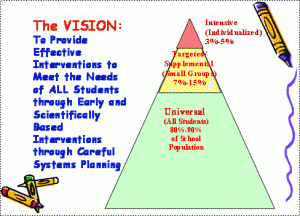What is RTI? ‘Response to Intervention’ (RTI) is an emerging approach to the diagnosis of Learning Disabilities that holds considerable promise. In the RTI model, a student with academic delays is given one or more research-validated interventions. The student’s academic progress is monitored frequently to see if those interventions are sufficient to help the student to catch up with his or her peers. If the student fails to show significantly improved academic skills despite several well-designed and implemented interventions, this failure to ‘respond to intervention’ can be viewed as evidence of an underlying Learning Disability. One advantage of RTI in the diagnosis of educational disabilities is that it allows schools to intervene early to meet the needs of struggling learners. Another is that RTI maps those specific instructional strategies found to benefit a particular student. This information can be very helpful to both teachers and parents.
What Are the Essential Components of RtI?
- Utilization of the problem-solving approach, involving building-based personnel and parents, to improve outcomes for ALL students
- Delivering high quality, research-based instruction and behavioral support in general education (NASP, 2007; Batsche et al, 2006)

- Universal (school-wide or district-wide) screening of academics and behavior in order to determine which students might need closer monitoring or additional interventions (NASP, 2007)
- Frequenly monitoring targeted students’ rates of progress and levels of performance in comparison to peers to make more effective and efficient decisions (Batsche, et al, 2006)
- Multiple tiers of increasingly intense scientific, research-based interventions that are matched to student need (NASP, 2007)
Forms
- Problem-solving Forms coming soon
Educator Resources
- Florida Center for Reading Research

- National Center on Student Progress Monitoring
- Intervention Central
- Illinois ASPIRE
- AIMSWeb